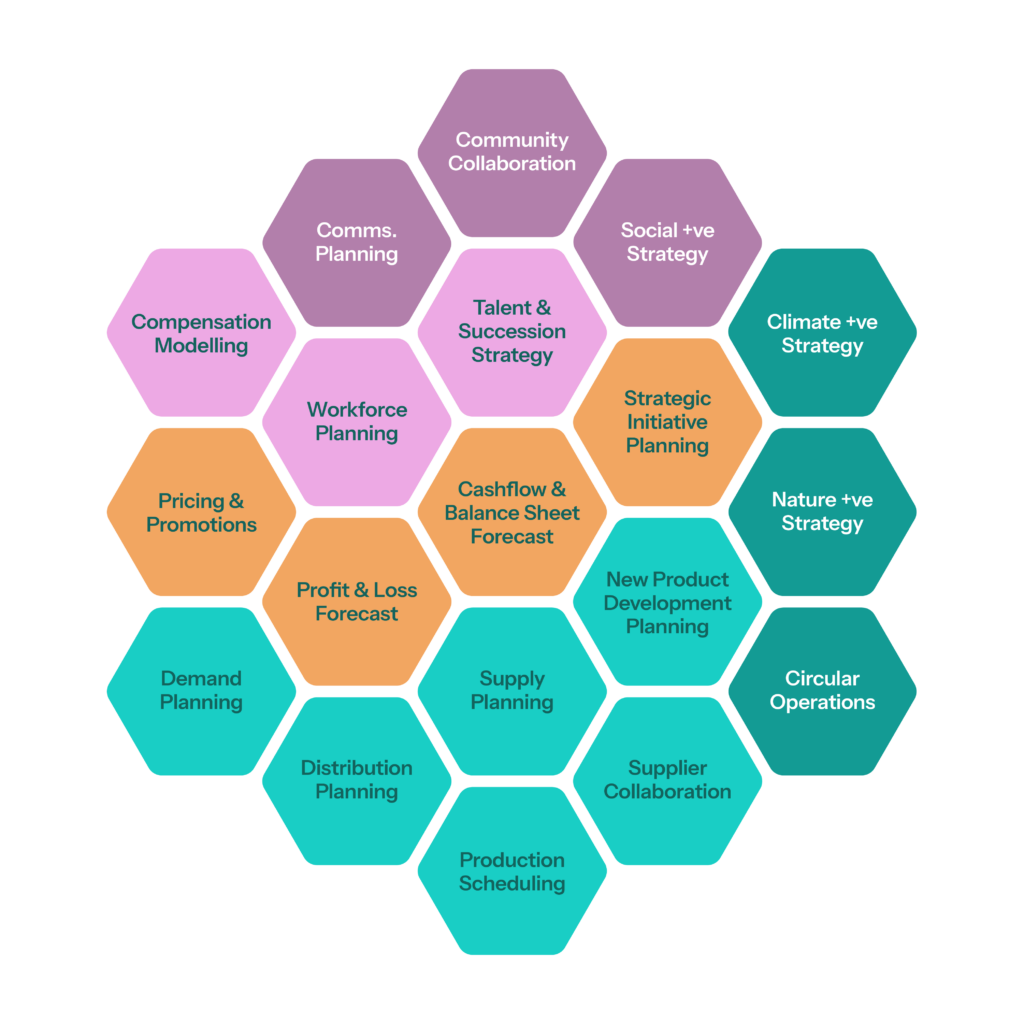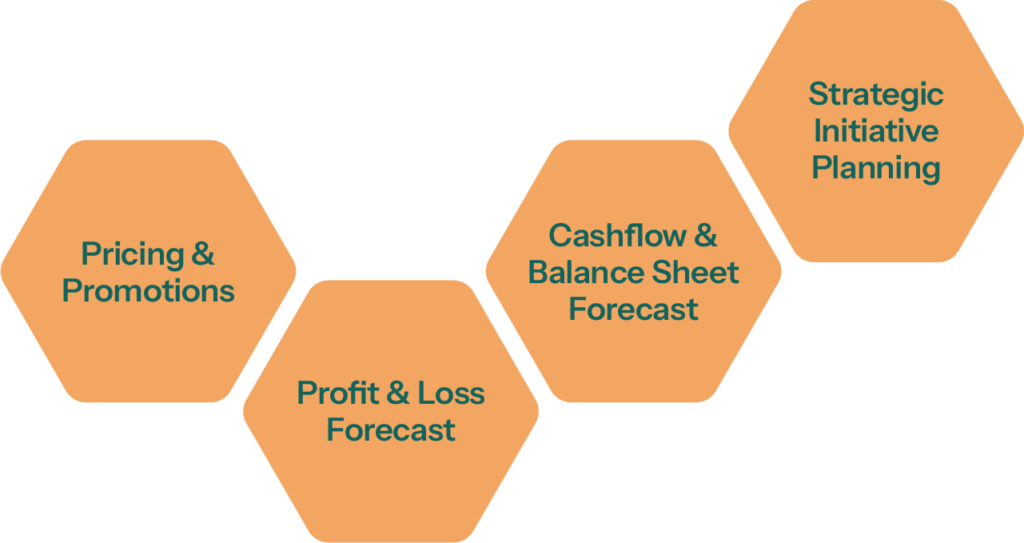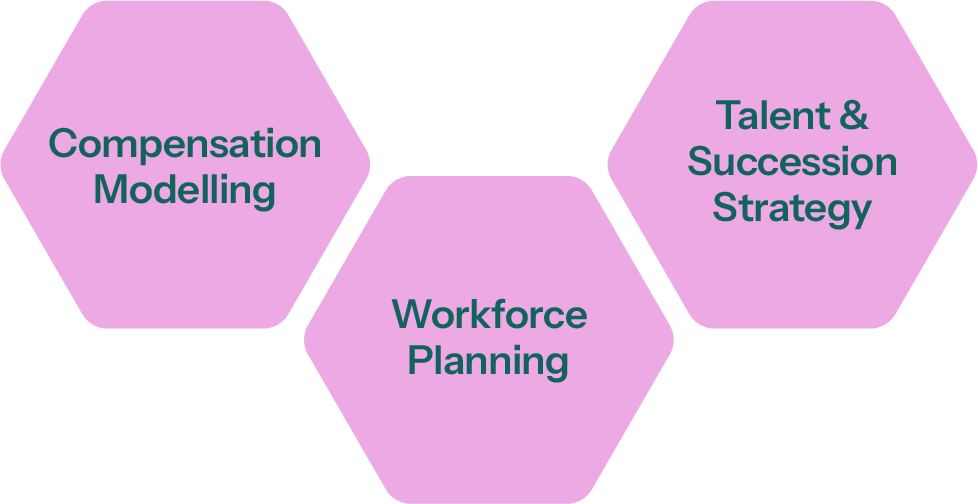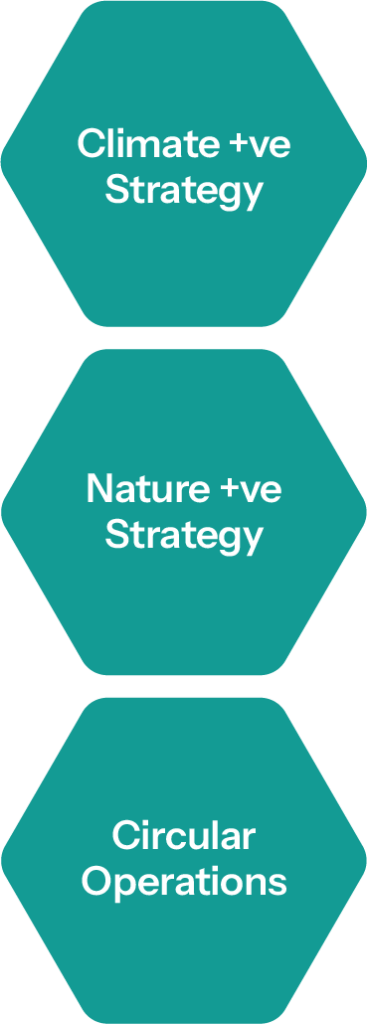Our Solutions:
Everything is connected
- JOIN THE DOTS
Business planning processes are often siloed and disconnected from each other. Let us help you to join the dots to improve the agility of your business
Sustainable Business Planning (SBP)
Embedding sustainability into strategy, operations, and culture is essential for organisations aiming to drive positive change in their business and sustainability impact. We’re pioneering a new approach to business planning, which we call Sustainable Business Planning (SBP).
There are five interconnected planning domains in SBP:

FINANCIAL PLANNING AND ANALYSIS (FP&A)

Pricing & Promotions
Trade Promotions Management (TPM) and Promotions Management for Retail (PMR) require rapid analysis and iteration of promotional plans over the promotional lifecycle, in response to changing market conditions and inventory holdings. These plans need to be synchronised in near real-time with invoicing systems, marketing teams, and merchandise planning processes.
Profit & Loss Forecast
Profit & Loss Forecasting is generally performed annually (the budget), and then quarterly/monthly to forecast Revenue and Expenses.
The forecast normally includes sub-modules such as:
- Sales & Margin (by Customer, Product and Channel)
- Salaries and Wages (staff costs and headcount planning either by person or grade)
- General Expenses (typically data entry, last year plus uplift or using driver-based profiling)
- New Assets Forecast (to calculate depreciation expense)
Cashflow and Balance Sheet Forecast
Managing cash – ensuring that you can continue trading – is the highest priority for most finance departments. This is especially true in seasonal businesses with large cash inflows and outflows over the course of the year.
Zooss Consulting has developed the Cashflow Planner template with auto-balancing balance sheet forecast, to make cashflow planning simpler and more reliable.
Strategic Initiative Planning
Top-down strategic planning involves the assessment of a range of initiatives which each have a business case attached to them. This process needs to be connected to the bottom-up P&L forecast, the cashflow plan, and have a transparent ranking mechanism to show all stakeholders what major decisions are being made, and why.
SUPPLY CHAIN PLANNING (S&OP)

Demand Planning
Demand planning is a more scientific version of sales forecasting, using statistical extrapolation of past sales to predict future sales.
This ‘stat forecast’ is the baseline demand plan, which is then adjusted by the sales team, marketing team, and sometimes the customers themselves, to give a consensus ‘unconstrained’ demand plan.
Supply Planning
The unconstrained plan is passed to Supply Planning, and a ‘constrained’ plan is returned, showing what can be produced. There are three steps in the supply planning process:
- Inventory Planning
- Material Requirements Planning (MRP) including third party manufacture (3PM), and
- Rough Cut Capacity Planning (RCCP)
This constrained plan is then passed to Distribution Planning to finalise customer allocations, and to Production Scheduling to plan production shifts.
Distribution Planning
Distribution Planning is the process of allocating finished good inventory to likely customer orders, and then getting it to the closest distribution centre to enable a quick shipment to a customer. Optimisation of space, both in warehouses and on trucks, is an important consideration.
Production Scheduling
Production Scheduling is the process of allocating production from Supply Planning to actual work centres (e.g. machines or production lines). Each work centre has different parameters – throughput, staffing, shift hours, maintenance requirements etc. and, as with distribution planning, the planning process benefits from the use of optimisation algorithms to achieve the most efficient outcome.
Supplier Collaboration
Traditionally, supplier collaboration has involved the exchange and confirmation of purchase orders, promotional plans and other changes in trading terms. In a Sustainably Planned Business, supplier portals are expanded to help gather carbon, water and energy footprints from the upstream supply chain, as well as modern slavery and other social sustainability data.
New Product Development (NPD) Planning
NPD planning has two parts:
- Development programme management, assessing the viability of a new product projects through various stage gates to commercialisation
- The incorporation of successful new products into demand and supply plans
The Sustainably Planned Business will also include environmental and social sustainability criteria in the NPD assessment process and ensure that these become part of an extended Bill of Materials (BOM), providing a more holistic view of product impact.
WORKFORCE PLANNING

Compensation Modelling
Align compensation strategies and costs with organisational goals. Model compensation – including salary, bonuses and incentives – to ensure the structure is equitable and congruent with value contributed to the organisation. Integrate HR data to automatically inform compensation plans.
Workforce Planning
Plan and model headcount against financial budget and growth projections. Incorporate hiring, attrition, role ramp-up time, and team-role ratio assumptions and all costs.
Forecast your workforce supply using assumptions for hiring, mobility and turnover, and align workforce to supply and demand.
Talent & Succession Strategy Planning
Identify talent gaps, model “what-if” scenarios, and assess financial, social and environmental impact to optimize your workforce and manage risk.
ENVIRONMENTAL SUSTAINABILITY PLANNING

Circular Operations Planning
The three principles of the Circular Economy (CE) – Material Efficiency, Material Circularity and Regeneration Modelling for CE – can include:
- Analysing and maximising material efficiency, circularity and the demerging of technical and biological materials
- Value capture of innovative business models (servitisation of products, co-ownership)
- Extended producer responsibility: modelling the take-back of goods or materials
- LCA – comparison of life cycle impacts caused and/or offset by new operating models and identifying efficiency tipping points
- Material and operational cost comparisons (e.g. virgin vs. non-virgin, tech A vs. tech B)
- Maximising regenerative potential (positive integration points with biological cycle)
- Mapping facilitating infrastructure availability, efficiency and risks
- Modelling technical and biological cycle touchpoints
- Repairability/disassembly analysis
Nature Positive Strategy
As well as minimising negative impacts, the Sustainably Planned Business should aim to create positive impacts on natural systems, on which they depend for value creation.
This can include:
- Regeneration of soil
- Re-diversification of species and habitats
- Building species numbers
We can use connected planning to model touchpoints with natural systems, both upstream and downstream, and identify:
- Interaction with and reliance on natural systems
- Level of impact
- Positive and Negative feedback loops
- Revenue generation opportunities (nature positive products and services)
- Opportunities for proactive nature positive interventions in the supply chain
- Design and management strategies for nature positive impacts, downstream
- Removing toxins from soil and water
Climate Positive Strategy
‘Climate Positive’ means you are removing more greenhouse gasses from the atmosphere than you are responsible for emitting.
This can be at an organisation level or a product level, and requires both deep decarbonisation and facilitation of sequestration, both within and beyond your organisation’s boundary.
Modelling Scope 1, 2, and 3 emissions in line with scientific best practice, and incorporating these into every element of business planning, is essential to achieve Climate Positive status.
SOCIAL SUSTAINABILITY PLANNING

Communications Planning
The Sustainably Planned Business needs well-planned feedback loops with internal and external stakeholders to continue to adapt and evolve. These could be:
- External/internal communications and marketing
- Channel-specific messaging
- Customer feedback mechanisms
- Evaluation/success metrics
Community Collaboration
In addition to direct stakeholders, the Sustainably Planned Business also needs to safeguard its social licence by collaborating with the wider community to achieve shared goals. These could involve:
- Facilitating and encouraging no or low-cost knowledge sharing, learning opportunities, and data sharing
- Inter-industry collaborations, partnerships, and joint ventures
- Stakeholder engagement for Circular Economy business models
- “Suppliers as Community” – modelling the supplier network, synergies, and collaboration potential
Social Positive Strategy
A Socially Positive strategy will aim to improve the health and wellbeing of the wider community, through initiatives such as:
- Innovative ownership structures aimed at wider distribution of wealth
- Servicing traditionally underserviced/underprivileged sectors of the population
- Identifying social feedback loops and positive impact touchpoints
- Proactive support, development or assistance for underrepresented groups
- Benefits of planning sustainably
The relationship between finance and sustainability management is increasingly important - Sustainable Business Planning is designed to seamlessly integrate sustainability data with real-time financial tracking and reporting
By integrating environmental and social sustainability planning into financial, supply chain and workforce planning, business can:
-
Improve financial performance via increased access to low-cost capital and supply chain optimisation
-
Increase revenue through innovation and new product development
-
Strengthen brand and disclosure integrity
-
Grow customer and shareholder appeal
-
Decrease exposure to non-compliance risk for sustainability reporting, climate litigation, and potential loss of investor confidence
-
Predict and improve environmental and social impact outcomes
